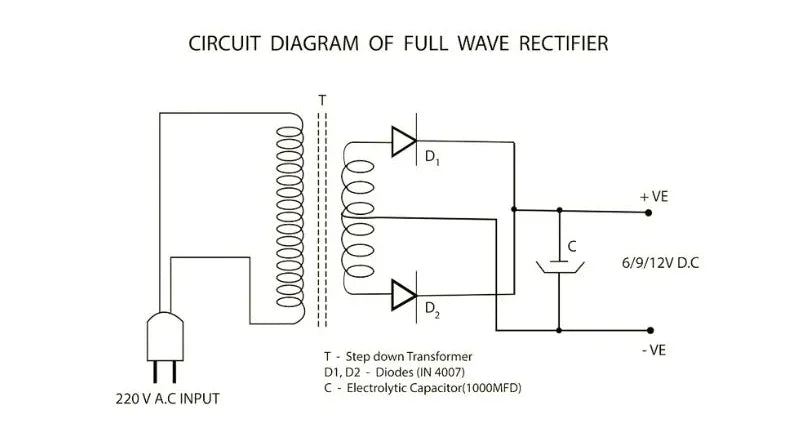
Advantages of Full Wave Rectifiers
The following figure shows the circuit diagram of a full-wave rectifier.

The full-wave rectifier contains diodes D1 and D2, which are connected to the center-tapped secondary coil of a transformer and a load resistor (RL). There is an alternating current source in the primary coil of the transformer. Note that only half of the total secondary voltage is used for each diode.
Half wave rectifier
A half-wave rectifier is a basic electronic component that converts alternating current (AC) to direct current (DC). Unlike full-wave rectifiers, half-wave rectifiers use only half of the input waveform during operation. During the positive half cycle of the AC input, it conducts and allows current to flow in one direction, while during the negative half cycle it blocks the current. As a result, the output of a half-wave rectifier is characterized by a pulsating DC voltage, which makes it less efficient and suitable only for certain applications where a continuous and stable DC supply is not crucial.
Operation during positive and negative half cycles

During the positive half cycle of the AC input, terminal A is positive with respect to B. Diode D1 is forward biased, allowing current to flow through it, and a voltage is developed across load resistor RL.
During the negative half cycle, connection A is negative with respect to B. Diode D2 is forward biased and current flows through load resistor RL.
Rectified current flows in the same direction through RL during conduction in one of the two diodes. Diodes D1 and D2 conduct alternately and both halves of the input appear at the load. Therefore the circuit works like a full wave rectifier. The DC output voltage is positive for the common cathodes of the diodes.
During the positive half cycle of the AC input, terminal A is positive to B. Diode D 1 is biased in the forward direction. Current therefore flows through diode D 1, and voltage arises across the load resistor R M Solid arrows indicate the direction of the current.
During the negative half cycle, connection A is negative compared to B. Diode D 2 is biased in the forward direction. Consequently, the dotted arrows indicate that current flows through the load resistor RL.
Peak reverse voltage
Each diode in a full-wave rectifier is alternately forward and reverse biased. If diode D 1 is forward biased, the voltage across the non-conducting diode D 2 is equal to the sum of the voltage in the lower half of the secondary coil and the load resistance, i.e. the maximum diode voltage VD 2 =V M – (-V M ) =2V M .
ripple factor
Correction efficiency
Additional considerations
Now let's explore some additional aspects of full-wave rectifiers:
Merits:
- Compared to a half-wave rectifier, the output voltage is continuous.
Disadvantages:
- It is not easy to find the center tap of the secondary winding.
- The diode used must have a high PIV.
- The DC output is low because each diode uses only half of the transformer's secondary voltage.
- A center-tapped transformer is required.
Applications of Full Wave Rectifiers

Full wave rectifiers are used in various applications due to their advantages and efficiency. Some common applications are:
Energy Supplies
Full-wave rectifiers are a fundamental part of power supplies for electronic devices. They convert the incoming AC voltage into a stable DC voltage needed to power the circuits.
Charging the battery
Full-wave rectifiers ensure that the battery receives a continuous, regulated DC voltage into the battery's charging circuits, enabling efficient charging.
Audio amplification
Full-wave rectifiers convert AC audio signals into a DC bias voltage, which is necessary for proper amplification in audio amplifiers.
Motor control
In motor control circuits, full-wave rectifiers convert AC voltage to a regulated DC voltage to drive motors and control their speed.
Conclusion
Full-wave rectifiers are crucial for the efficient conversion of AC to DC voltage and are therefore a fundamental part of several electronic applications. Understanding its functionalities, properties and applications is essential for anyone working with power electronics. Full-wave rectifiers remain essential in modern electronics, whether in power supplies, battery charging, audio amplification or motor control.
Common questions
1. What is a full wave rectifier?
A full-wave rectifier is an electronic circuit that converts alternating current (AC) to direct current (DC) using both halves of the input waveform.
2. What is the peak reverse voltage (PIV) of a full-wave rectifier?
Peak reverse voltage (PIV) is the maximum voltage experienced by a non-conducting diode in a full-wave rectifier at reverse voltage. It is equal to twice the peak voltage of the AC input.
3. Where are full wave rectifiers commonly used?
Full-wave rectifiers are widely used in power supplies, battery chargers, audio amplification and motor control circuits due to their efficient conversion of AC voltage to stable DC voltage.

